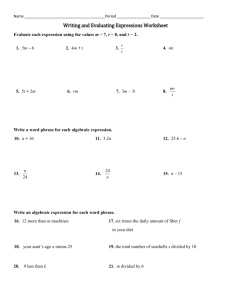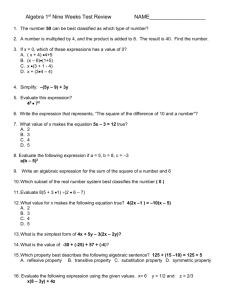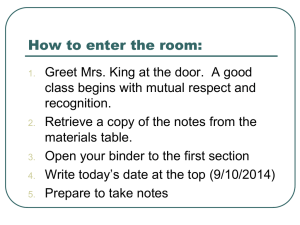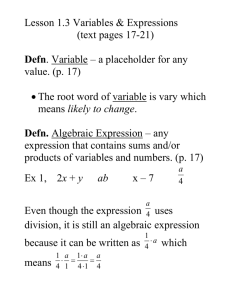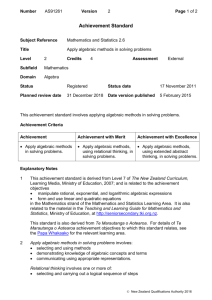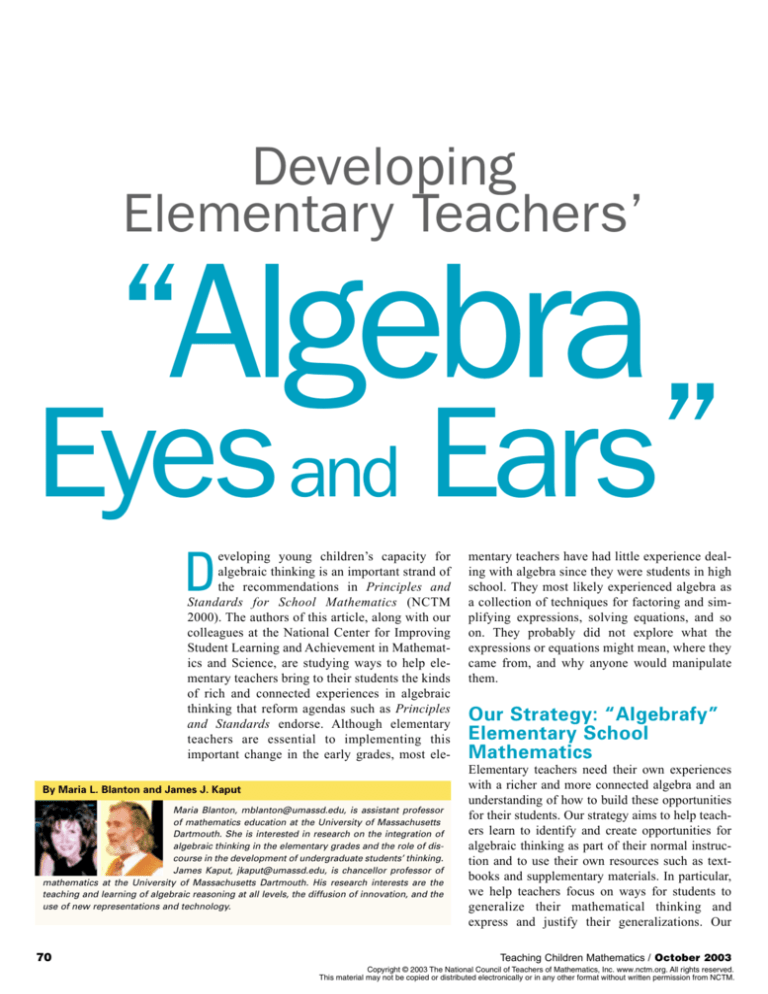
Developing
Elementary Teachers’
“Algebra
Eyes and Ears”
eveloping young children’s capacity for
algebraic thinking is an important strand of
the recommendations in Principles and
Standards for School Mathematics (NCTM
2000). The authors of this article, along with our
colleagues at the National Center for Improving
Student Learning and Achievement in Mathematics and Science, are studying ways to help elementary teachers bring to their students the kinds
of rich and connected experiences in algebraic
thinking that reform agendas such as Principles
and Standards endorse. Although elementary
teachers are essential to implementing this
important change in the early grades, most ele-
D
By Maria L. Blanton and James J. Kaput
Maria Blanton, mblanton@umassd.edu, is assistant professor
of mathematics education at the University of Massachusetts
Dartmouth. She is interested in research on the integration of
algebraic thinking in the elementary grades and the role of discourse in the development of undergraduate students’ thinking.
James Kaput, jkaput@umassd.edu, is chancellor professor of
mathematics at the University of Massachusetts Dartmouth. His research interests are the
teaching and learning of algebraic reasoning at all levels, the diffusion of innovation, and the
use of new representations and technology.
70
mentary teachers have had little experience dealing with algebra since they were students in high
school. They most likely experienced algebra as
a collection of techniques for factoring and simplifying expressions, solving equations, and so
on. They probably did not explore what the
expressions or equations might mean, where they
came from, and why anyone would manipulate
them.
Our Strategy: “Algebrafy”
Elementary School
Mathematics
Elementary teachers need their own experiences
with a richer and more connected algebra and an
understanding of how to build these opportunities
for their students. Our strategy aims to help teachers learn to identify and create opportunities for
algebraic thinking as part of their normal instruction and to use their own resources such as textbooks and supplementary materials. In particular,
we help teachers focus on ways for students to
generalize their mathematical thinking and
express and justify their generalizations. Our
Teaching Children Mathematics / October 2003
Copyright © 2003 The National Council of Teachers of Mathematics, Inc. www.nctm.org. All rights reserved.
This material may not be copied or distributed electronically or in any other format without written permission from NCTM.
Photograph by D. Confar; all rights reserved
“algebrafication” strategy involves three types of
teacher-based classroom change: algebrafying
instructional materials, finding and supporting students’ algebraic thinking, and creating classroom
culture and teaching practices that promote algebraic thinking.
Algebrafying instructional
materials
This term refers to generating algebraic activities
from available instructional materials. Existing
arithmetic activities and word problems are transformed from problems with a single numerical
answer to opportunities for pattern building, conjecturing, generalizing, and justifying mathematical facts and relationships. Varying the given parameters of a problem is one simple yet powerful
method. This is easily done with familiar tasks
such as the Handshake Problem, which typically is
posed as an arithmetic task with a single numerical
answer: “How many handshakes will there be if
each person in your group shakes the hand of every
person once?” Students need simply to compute a
sum, although they might first draw a picture or
diagram to keep track of the people shaking hands.
Teaching Children Mathematics / October 2003
For example, they might record the initials of the
person whose hand was shaken or draw a set of figures with lines between them indicating who has
shaken hands. Tyler, a visually impaired student,
used adaptive equipment to participate in the activity (see fig. 1).
To algebrafy the Handshake Problem, simply
vary the number of people in the group (see fig. 2).
How does this lead to algebraic thinking? By varying the number of people in the group, students are
able to generate a set of data that has a mathematical pattern. A subtle but important part of this task
is asking students about the number of handshakes
for a group whose size is sufficiently large so that
students cannot (or would not want to) draw or
model the problem and write down a corresponding sum to compute. That is, to determine the
number of handshakes in a group of 100, students
cannot simply compute a sum; they must identify
a pattern and think about how the amounts of
handshakes for the various groups are related. (We
refer to this as algebraic use of numbers.) From
this, they can make a conjecture that describes
what is true about the number of handshakes for a
group of any size. When they support their conjec71
Figure 1
Photograph by D. Confar; all rights reserved
Tyler, a visually impaired student, used tactile tools to record data for
the Handshake Problem. To add the numbers, he used a Brailler and an
abacus.
Figure 2
“Algebrafying” the Handshake Problem
ture with sufficient evidence, the conjecture
becomes a generalization, or a statement that
describes a general truth that applies across multiple specific cases.
As another example, consider the following
simple arithmetic task:
I want to buy a T-shirt that costs $14. I have $8
already saved. How much more money do I
need to earn to buy the shirt?
This problem can be extended to an algebraic
task in several ways, such as by varying the cost of
the shirt:
Suppose the T-shirt costs $15, $16, $17, or $26.
For each of these cases, write a number sentence
that describes how much more money I need to
buy the item. If P stands for the price of any Tshirt I want to buy, write a number sentence
using P that describes how much more money I
need to buy the T-shirt.
The underlying idea of this transformation is simple: Start with a typical numerical task and generalize it to a sequence of problems, each of which
can be solved by an accompanying number sentence. The result is a sequence of number sentences
that can be used to determine a generalized statement that captures the entire sequence in one statement; that is, $P – $8 = amount needed to earn. The
intent is to get students to move beyond the arithmetic task and to think about the problem in general. Algebrafying tasks in this way is very flexible.
To address a particular arithmetic reasoning
agenda—multiplication, for example—you can
vary the givens in a situation as follows:
Jack wants to save up to buy a CD player that
costs $35. He makes $5 per hour babysitting.
How many hours will he need to work in order
to buy the CD player?
Suppose that the price of the CD player varies; it is
on sale for $30, or Jack decides to buy a more
expensive one at $45. If you want to stress multiplying by 7, give Jack a raise to $7 per hour. Varying one of the problem givens in these ways creates
a sequence of problems about which students can
make a generalized statement such as “The number
of hours Jack needs to work is the cost of the CD
player divided by Jack’s hourly wage.” As applied
mathematician Richard Hamming notes, “The pur-
72
Teaching Children Mathematics / October 2003
pose of computation is not numbers, it’s insight”
(Hamming 1962, epigraph).
Given the hectic pace of today’s classrooms, a
powerful benefit of using algebrafied arithmetic
tasks is that students do many important things at
once, including developing number sense, practicing number facts, and recognizing and building
patterns to model situations. Algebrafied problems
such as these can provide large amounts of computational practice in a context that intrigues students
and avoids the mindlessness of numerical worksheets. Moreover, these tasks can be generated
directly from existing materials.
Teachers must focus on student thinking in order to
develop their “algebra eyes and ears.” They should
ask simple questions such as the following:
•
•
•
•
Tell me what you were thinking.
Did you solve this a different way?
How do you know this is true?
Does this always work?
These questions not only reveal students’ thinking
but also prompt students to justify, explain, and
build arguments—processes that lie at the heart of
algebraic reasoning. Focusing on student thinking
helps teachers see the depth, variety, and originality of students’ arguments and often makes them
think deeply about students’ algebraic reasoning
and the kinds of mathematical tasks that support it.
Students demonstrate the beginnings of algebraic
reasoning when they use particular numbers to
argue a general case, or when they intend for a particular number to stand for any number and use
gestures and vocal emphases to make their intent
apparent. One third-grade teacher with whom we
work described how students argued that “odd +
even = odd”:
The only confusion came when Sarah said
that odd plus even was odd and even plus odd
was even. Stephen responded that that
couldn’t be. He used numbers in place of
“odd” and “even” and said that using “odd”
and “even” was the same as using letters.
Sarah explained to the class, “I thought that
all the time when odd is the first one it was
supposed to be odd, and when even was first
it was going to be even. [But then I realized
that wasn’t correct] because once you start
Teaching Children Mathematics / October 2003
Photograph by D. Confar; all rights reserved
Finding and supporting
students’ algebraic thinking
turning them around, then it’s the same thing.
It doesn’t make a difference.”
This vignette shows that Stephen recognized the
terms “even” and “odd” as placeholders that he
could replace with any even or odd numbers in
order to reason about the sum. By explaining her
thinking, Sarah was able to show how she used the
generalization that addition is commutative to
examine her own claim. When a child makes a generalization such as “Once you start turning them
around, then it’s the same thing. It doesn’t make a
difference,” the teacher can push this algebraic
thinking by asking the student why this might be
true. The teacher can extend students’ algebraic
thinking further by changing the operation: “Do
you think this is true when we subtract numbers or
multiply numbers? Why or why not?”
When students attempt to use computation to
solve tasks that they could better solve by reasoning algebraically, teachers can change the problem
to use numbers beyond students’ arithmetic capacity. For example, finding the number of handshakes
in a group of one hundred people is far too cum73
bersome to solve by drawing the problem, recording every act of shaking hands, and computing the
sum that results. The problem requires another
technique. When students try to make a generalization about the sum of an even number and an odd
number, they may focus on adding particular numbers instead of looking at properties of even and
odd numbers. The teacher can change the numbers
in question in order to shift the focus away from
arithmetic to algebraic thinking. The following
classroom episode, in which a teacher asked a student if the sum of 5 + 7 is even or odd, illustrates
this:
occasional “enrichment” separate from the regular
work of learning and practicing arithmetic. The
following episode from Gina’s first-grade classroom illustrates a classroom culture with these values. First, Gina took the arithmetic task “What is
the greatest number of outfits you can make with 2
pairs of pants and 5 shirts?” and algebrafied it by
varying the number of shirts or pants. Because this
was a first-grade class, she created constructionpaper cut-outs of different colors of shirts and
pants that students could affix to the easel paper on
which she recorded their comments. She made the
following observations:
Teacher. How did you get that?
Tory. I added 5 and 7, and then I looked over
there [indicating a list of even and odd numbers on
the wall] and saw that it was even.
Teacher. What about 45,678 plus 85,631? Odd
or even?
Mary. Odd.
Teacher. Why?
Mary. Because 8 and 1 is even and odd, and
even and odd is odd.
I asked, “How many outfits can you make with
this one red shirt, red pants, and blue pants?”
Many children responded, “One.” At this point,
I needed to identify the meaning of outfit. Most
students wanted to put like colors together. Each
pair of partners then was instructed to pair red
with red, and then blue with red. Then the action
began. We recorded the information on chart
paper. Another shirt was added to the two pairs
of pants. Partners shared information and
recorded it on the chart paper [see fig. 3]. I recognized that they needed to see this visually.
After several activities and adding pants and
shirts, the children were anxious to make predictions. After completing up to three shirts, the
children began to see a pattern in the third column of outfits. Many responded, “We are counting by twos.” Nathan recognized that 2 + 2 is a
double and wondered if three shirts and three
Students in this class had already discussed the
result of adding even and odd numbers. By using
sufficiently large even and odd numbers, the
teacher eliminated the students’ capacity to compute the sum, forcing them to think about the
properties of the numbers. Mary knew that she
needed to consider only the last digit of the two
numbers and did not need to compute the actual
sum. In fact, she did not even compute 8 + 1. She
simply noted that 8 is even and 1 is odd, then used
the generalization that “even + odd = odd” to get
her solution.
Focusing on student thinking enables the
teacher to see these types of situations as opportunities to engage students in making generalizations
and in making those generalizations more explicit.
This is an important aspect of having “algebra eyes
and ears.”
Creating a classroom culture
and practices that promote
algebraic reasoning
Promoting algebraic reasoning in the classroom
involves incorporating conjecture, argumentation,
and generalization in purposeful ways so that students consider arguments as ways to build reliable
knowledge. It requires respecting and encouraging
these activities as standard daily practice, not as
74
Figure 3
The classroom chart used for the Outfit
Problem
Shirts
Pants
Outfits
1
2
2
2
2
4
3
2
6
Figure 4
Sample in/out chart
IN
OUT
1
3
2
6
3
9
Teaching Children Mathematics / October 2003
pants would be six. He was able to figure out
that there were nine outfits. We then used three
shirts and four pants. Nathan predicted fourteen.
Cory predicted ten and then said, “Let’s do it to
see.” Matthew said, “Well, if one shirt and three
pants is three outfits, then we just have to keep
adding three.”
Gina had created an environment that valued students modeling, exploring, arguing, predicting,
conjecturing, and testing their ideas, as well as
practicing computational skills. We promote the
kind of mathematical talk described here, in which
the teacher deliberately pushes students to generalize their thinking and build verbal and written
arguments to justify their ideas. In this way, algebraic reasoning opportunities occur frequently and
are viable. A classroom practice that supports conjecture, argumentation, generalization, and justification ensures that the two other parts of our algebrafication strategy—teachers’ algebrafication of
instructional resources and their focus on students’
thinking—can be reproduced and sustained over
the long term.
What Does an Algebrafied
Practice Look Like?
How do we know when a classroom practice has
been algebrafied? In our work with teachers, we
focused on the classroom practice of one thirdgrade teacher participant, Jan, who seemed to be
algebrafying her classroom practice in a way that
reflected our goals. We used a one-year case study
of her classroom (Blanton and Kaput, forthcoming) to identify characteristics of Jan’s practice that
brought out the algebraic character of the mathematics. What follows is a discussion of these characteristics and classroom vignettes that illustrate
them.
Algebraic themes are spiraled
over periods of time
Jan did not treat an activity as an isolated task but
instead revisited certain themes, such as relationships in data, properties of even and odd sums, or
the use of letters to symbolize unknown or varying
amounts, throughout the year in increasingly complex ways. For example, early in the year students
used “in/out” charts to identify simple additive
relationships in the “out” column. Students could
determine that the “out” column in figure 4 was
increasing by 3 after looking for patterns in the colTeaching Children Mathematics / October 2003
Figure 5
A three-desk configuration for the Trapezoid Problem
umn. During the year, this task progressed to looking at relationships between the “in” and “out”
columns and identifying and symbolizing these
functional relationships. Relationships between
numbers were most clearly described later in the
year as students solved the Trapezoid Problem,
which required finding the number of people who
could be seated at trapezoidal tables, modeled by
adjoining various numbers of trapezoid pattern
blocks (see fig. 5).
Students found the number of people who could
sit at a table constructed of twelve trapezoid blocks
by looking for a pattern in the data that described
how many people could be seated at tables made of
one, two, three, and four trapezoid blocks. They
were focused on a pattern in a single data set,
rather than a relationship between data sets. Jan
described what occurred next:
The strangest thing happened! I saw another pattern. I asked the class to look at the chart in
another way. I wanted them to look at the relationship between the desks and the number of
people. Find the rule. No luck. I then gave them
the hint to see if there was a way to multiply and
then add some numbers so it would always
work. Jon suggested that we try to find a “secret
message.” After a few minutes, surprisingly,
Anthony and Alicia started to multiply the number of desks with different numbers starting with
1. The two children found the rule of multiplying by 3 and then adding 2. We tried many examples from the chart and it worked each time. We
even tried some big numbers like 100. We then
tried to make a secret message. Andrew said that
the 3 stays the same, so use a d for desk. This is
what he came up with: 3(d) + 2 = number of peo75
ple. The students realized that the 3 came from
the people who could sit “on the top and the bottom” and the 2 came from the 2 sides.
Jan was able to spot ways to exploit algebraic
thinking. In this case, she prompted students to
think about relationships between data and to symbolize that in a fairly sophisticated way. The activity brought together a number of themes that Jan
had addressed throughout the year: generating and
organizing data, looking for patterns in single data
sets, looking for relationships between quantities,
symbolizing relationships in mathematically efficient ways (moving beyond everyday language),
testing conjectures, and justifying mathematical
generalizations. Each of these is a process that
should become a habit of mind for elementary students. This will happen only if these processes
become a routine part of classroom instruction.
Algebraic conversations
are incorporated in the
classroom on a regular and
often spontaneous basis
Jan was able to engage students naturally in conversations that required them to generalize their
thinking. She spontaneously shifted the focus
away from computation to algebraic thinking during a rather ordinary task. Moreover, Jan’s reflection about the Trapezoid Problem—“The strangest
thing happened!”—shows that finding a relationship between the number of desks and the corresponding number of people was a spontaneous
decision. The remainder of the conversation, in
which students developed what they described as a
secret message—“3(d) + 2 = number of people”—
shows the flexibility with which Jan could extend
the opportunity for algebraic thinking.
Teachers can identify or
create arithmetic tasks that
can be algebrafied
One of our most important goals is that teachers
will be able to create their own set of instructional
materials by algebrafying their existing resource
base, so they are not dependent on the materials
that we provided. Our intent was not to add on to
teachers’ own materials but to give them new, algebraic ways to look at what was already available.
Shortly after her class had solved the algebrafied
Handshake Problem (an activity we provided), Jan
developed an activity based on the song “The
Twelve Days of Christmas,” which her class was
76
learning for a school production. The simple task
was stated as follows:
How many gifts did your true love receive on
each day? How many total gifts did he or she
receive on the first 2 days? The first 3 days? The
first 4 days? If the song was titled “The TwentyFive Days of Christmas,” how many total gifts
would your true love receive?
Jan’s problem had the same pattern and structure as
the Handshake Problem. She selected the Trapezoid
Problem described earlier because she was inspired
by her committee work to select new school furniture. Her creativity in integrating algebraic thinking
into a musical activity for her class and her capacity to see overlooked resources in new ways (the
Trapezoid Problem was part of her existing
resource base) are significant. Both examples show
how she was learning to spot opportunities for algebraic thinking in places that were not obvious; she
was developing “algebra eyes and ears.”
Teachers contribute to the
development of a schoolwide culture of learning
mathematics
The transformation that took place in Jan’s classroom was not confined to the classroom or to her.
With the support of her principal, she began to share
with her colleagues both formally and informally
what she was learning. She wrote, “I am slowly getting my student teacher into using one math problem that can be extended [algebrafied].” The student
teacher gave the following problem to the class:
The Millerville School is holding a car wash. A
group of students can wash 6 cars in 1 hour.
Suppose 2 groups of students wash cars at the
same time. How many total cars could the
groups wash in 3 hours? How many hours
would it take to wash 72 cars?
Creating time to incorporate activities that involve
algebraic thinking was one of the constraints that
Jan and other teachers faced. As the examples here
illustrate, these activities typically not only extend
a “short” arithmetic task but also require studentcentered discussions so that conjecturing and justification will thrive. As a school leader of a districtwide literacy initiative, Jan has worked to integrate
algebraic thinking into her school’s literacy program. Embedding the ideas of algebraic thinking
Teaching Children Mathematics / October 2003
into another subject area not only freed instructional time but also made both literacy and algebraic thinking more relevant for teachers. As an
outgrowth of this endeavor, Jan has taken a lead
role in establishing Monthly Math, a school-based
project in which teachers identify “back of the
textbook” concepts that often are overlooked and
create a set of activities across the grades in which
the whole school can participate. The result has
been a growing school-wide appreciation of the
more complex kinds of mathematics of which students are capable. As one teacher described,
Monthly Math “united the school.” We might add
that such activities are also beginning to “algebrafy” the school.
A practice that includes the components
described in this article can emerge from our algebrafication strategy and resources. This practice
can thrive independently of our intervention and
have an impact on the broader school culture. As
we found in Jan’s classroom, it also can lead to
greater student achievement on standardized tests
(Kaput and Blanton 2001).
References
Blanton, Maria, and James Kaput. Characterizing Generative and Self-Sustaining Instructional Practices
That Promote Algebraic Reasoning. Forthcoming.
Hamming, Richard. Numerical Methods for Scientists
and Engineers. New York: McGraw-Hill, 1962.
Kaput, James, and Maria Blanton. “Student Achievement in Algebraic Thinking: A Comparison of Third
Graders’ Performance on a State Fourth-Grade
Assessment.” In Proceedings of the XXIII Annual
Meeting of the North American Chapter of the International Group for the Psychology of Mathematics
Education, edited by R. Speiser and C. Maher.
Columbus, Ohio: ERIC Clearinghouse, 2001.
National Council of Teachers of Mathematics (NCTM).
Principles and Standards for School Mathematics.
Reston, Va.: NCTM, 2000.
The research in this article was supported in part
by a grant from the U.S. Department of Education,
Office of Educational Research and Improvement,
to the National Center for Improving Student
Learning and Achievement in Mathematics and
Science (R305A60007-98). The opinions expressed
here do not necessarily reflect the position, policy,
or endorsement of the supporting agencies. ▲
GUIDELINES FOR PREPARING ARTICLES
FOR THE 2006 NCTM YEARBOOK,
Thinking and Reasoning with Data and Chance
In modern democratic societies, individual citizens are empowered—perhaps more than ever before in any society—to make
countless decisions affecting education, health, money, careers, even the way they are governed. Citizens also have more access
to data, from public-opinion polls to medical-research findings to millions of Web pages having content of widely varying veracity. Faced with such freedoms, a barrage of information, and inevitably the uncertain consequences of their choices, every citizen
increasingly needs to understand the importance of statistics and probability. For the health of our society, education in prekindergarten through grade 12 must ensure that students learn to reason about and with data while taking into account uncertainty.
The 2006 Yearbook Editorial Panel extends an invitation to submit articles for its yearbook, Thinking and Reasoning with Data
and Chance. Potential authors should submit a first draft of their proposed manuscript by March 1, 2004. Preference will be given
to drafts of complete papers, although an outline of a paper will be considered provided it includes the introduction and the development of one or more sections of the proposed manuscript. Contributions from classroom teachers are particularly encouraged.
Editorial decisions are made by the members of the 2006 Yearbook Editorial Panel: Gail Burrill (Issue Editor), Portia C. Elliott
(General Editor), Floyd Bullard, Alfinio Flores, Sister Alice Hess, James Landwehr, and Christina Pateracki.
For detailed instructions, see “Guidelines for Preparing Articles for the 2006 NCTM Yearbook” on NCTM’s Web site
(www.nctm.org/publications/yearbook.htm). Questions about the guidelines may be addressed to Gail Burrill, (517) 432-2152,
ext. 133; fax: (517) 432-5653; e-mail: burrill@msu.edu, or to Portia Elliott, (413) 577-4450; fax: (413) 545-2876;
e-mail: pelliott@educ.umass.edu.
Teaching Children Mathematics / October 2003
77



